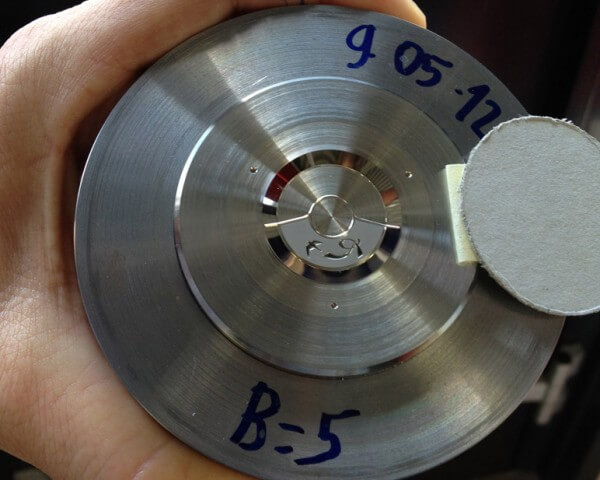Savoir-faire is a meaningful term at Cendres+Métaux Galétan, the Chaux-de-Fonds branch of Cendres+Métaux, which participated at the recent EPHJ show (Jewellery and Watchmaking Professional Environment) in Geneva. The company has developed the patented Etamir® concept, a combination of electroplating and stamping. This innovative surface treatment creates very impressive results: it can replace engraving or guillochage, imitate natural surfaces such as stone, and even reproduce holograms created by photolithography. The method, which was developed in a garage 20 years ago, is still shrouded in secrecy: only its general outlines have been published.
A negative imprint
The story begins in the mid-1980s. Pierre Mercier, a technician from La Chaux-de-Fonds returned from a year spent in the United States where he had gone to learn about electroplating. This industrial process improved the appearance of a surface, protected the material and even made it stronger with notably increased abrasion-resistance. The automotive industry was among the first to use the process widely. The principle is based on electrolysis: two metallic objects are immersed in a chemical bath with a direct electric current flowing from one to the other, allowing the deposition of particles from the first (the anode) onto the second (the cathode).
But Pierre Mercier had a different idea. Electroplating has a second property: it makes it possible to create a negative imprint, of the cathode object. He used this feature, combined with the stamping process, as the basis of the Etamir® method of producing stamping tools by electroplating. “Pierre Mercier spent 8 years developing it without making a penny,” explains Denis Villars, a director of Cendres+Métaux Galétan and a cousin of the inventor. “His brilliant insight was to combine the two techniques and his secret was in the chemical composition of the bath.”
From the original to the core
The first stage is to produce “the original”. In manufacturing an oscillating weight, for example, the decorated face is created on a brass disc or, in some cases, a gold disc to give the final surface a better finish. This operation is performed by mechanical milling or by laser, but also by hand in the case of engraving or guillochage. The disc is then immersed in the chemical bath. “It takes a week of galvanic growth to obtain a nickel imprint 3 – 3.5mm in thickness” explains Villars. This imprint, called an “inversion”, juxtaposes the metallic atoms to reproduce precisely the relief of the original. It can then be retouched, polished or given additional carving. When finished, the inversion is placed in the centre of a block of steel and becomes the “core”, the actual stamping tool.

The parent company, Cendres+Métaux in Bienne, acquired Galétan in 2008. It has strengthened its participation in the watchmaking sector by supplying the alloys and micro-mechanical machining used in the principal products of Cendres+Métaux Galétan. The basic discs are stamped 1-4 times at pressures of 60 to 180 tonnes depending on the desired result and the technical complexity of the final component. Cendres+Métaux Galétan produces not only oscillating weights in this way but also complicated dial appliques, moon-phase discs and special hands in precious metals. The process is sufficiently sophisticated and precise to produce fine engravings such as dragons – very much in fashion this year – as well as sunburst effects and even holograms. “This is our most recent development” says the Director. The hologram patch is created on the original by photolithography. This produces relief of 200 -250 nanometres (0.0002 – 0.00025 mm) which is enough to create the inversion. The result is astonishing.
Ethical objections
Just as astonishing is the imitation of natural materials: “for galvanic growth to occur the object concerned must be a conductor of electricity”. To make it a conductor, a flash or vacuum deposition of gold is all that’s required. By this method, electro-deposition works on any surface. “We have done it on slate and even on shark skin.”
While there is no objection to using the Etamir® concept in these two examples, this has not always been the case. “The method’s excellent results raised fears that it would kill craftsmanship,” says Villars. Twenty years later, everything has changed. “Now I believe we are seen as complementary. We will always need craftsmanship, particularly to produce the originals. We have even mixed the two techniques. For a dragon on an oscillating weight we produced the scales by stamping, and the engraver finished the animal by hand.”
Article published in BIPH
















